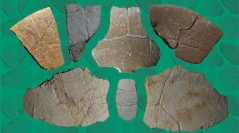

 Comptes Rendus Palevol
20 (32) - Pages 667-676
Comptes Rendus Palevol
20 (32) - Pages 667-676Bothremydidae is the most abundant clade of turtles in the Campanian and Maastrichtian (Upper Cretaceous) fossil record of southwestern Europe. Several members of Foxemydina Gaffney, Tong & Meylan, 2006 are known in an area that includes Southern France and the North-Eastern half of Spain. The problematic ‘Polysternon’ atlanticum is the worst characterized, lacking a diagnosis that allows its specific validity to be confirmed, and whose generic attribution has been recognized as doubtful. Its presence was exclusively proposed in its type locality, the upper Campanian quarry of Laño, in Treviño County (Burgos Province, North of Spain). Despite the fact that knowledge about Bothremydidae has markedly increased after the description of ‘Polysternon’ atlanticum Lapparent de Broin & Murelaga, 1996, no new information about this species has been published since the 1990s. The analysis of abundant unpublished material of the bothremydid from Laño allows us to confirm the validity of this species. As a consequence of this study, it is not only identified in its type locality, but also in other Spanish regions and in the south of France. The diversity of Bothremydidae Baur, 1891 in the Upper Cretaceous of Europe is lower than previously considered. Thus, the species ‘Iberoccitanemys convenarum’ (Laurent, Tong & Claude, 2002), originally defined for the French record, and subsequently also identified in Spain, is identified here as a synonym of the species described in Laño. An emended diagnosis for the upper Campanian to upper Maastrichtian, Iberoccitanemys atlanticum (Lapparent de Broin & Murelaga, 1996) n. comb., is proposed.
Pleurodira, Bothremydidae, Foxemydina, ‘Polysternon’ atlanticum, ‘Elochelys convenarum’, Late Cretaceous, new combination